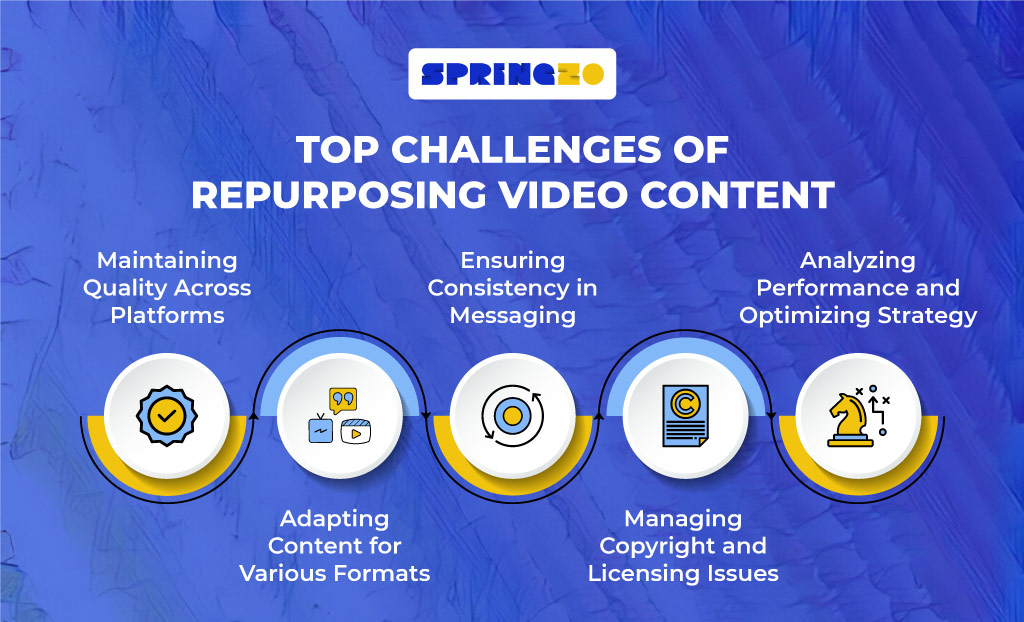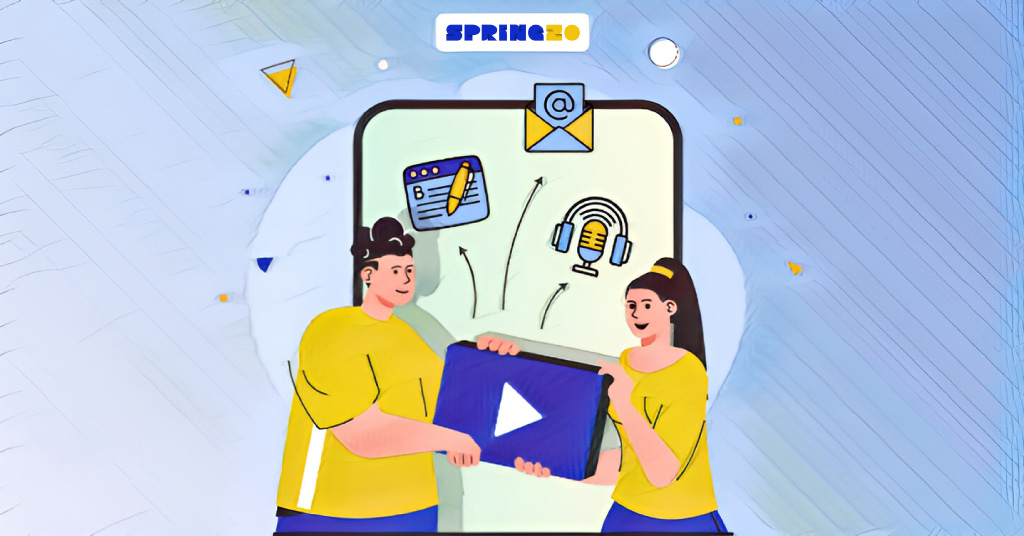When you decide to repurpose video content, you adopt a strategic modification and reuse of your existing video materials across various platforms. It has become crucial for effective digital marketing and audience engagement.
At present, video content is projected to constitute over 82% of all internet traffic.
The significance of repurposing lies in its capacity to maximize the reach and impact of video content across diverse audiences and platforms. With 91% of businesses utilizing video as a marketing tool, the ubiquitous nature of video content in modern marketing strategies is evident.
This widespread adoption emphasizes the need to understand the challenges associated with repurposing video content and the subsequent strategies required to overcome them. Addressing these challenges strategically becomes imperative for businesses aiming to navigate the dynamic world of digital marketing effectively.
This article highlights the top 5 challenges of video repurposing and ways to overcome them quickly.
Repurpose Video Content: Top 5 Challenges and Their Solutions

Let’s go over the critical challenges you must face head-on when you repurpose video content:
1. Maintaining Quality Across Platforms
One of the major hurdles in repurposing video content is the intricate task of preserving quality across diverse platforms. Each platform comes with its own set of specifications, ranging from resolution requirements to codec preferences. With YouTube alone boasting over 2.7 billion monthly active users, it highlights the vast diversity in audience across platforms.
The challenge is further exacerbated by the risk of potential loss in visual and audio quality during the repurposing process.
A multitude of compression algorithms and encoding methods contribute to this complexity. For example, YouTube favors the VP9 codec, whereas other platforms might lean towards H.264.
Striking a balance between file size and quality without compromising either is a delicate undertaking. To address this, implementing advanced compression techniques, such as perceptual coding and bitrate optimization, becomes crucial.
Additionally, adopting a multi-bitrate streaming strategy proves effective, providing different quality streams to accommodate users with varying internet speeds.
Solution
Preserving quality extends beyond technical specifications, involving a deep understanding of color grading, audio normalization, and resolution adjustments. Leveraging professional video editing software with advanced rendering options is essential for maintaining optimal quality.
Furthermore, incorporating adaptive streaming technologies, like Dynamic Adaptive Streaming over HTTP (DASH), enhances the user experience by dynamically adjusting quality based on the viewer’s internet connection.
This comprehensive approach ensures that video content retains its integrity across a spectrum of platforms, meeting the diverse demands of today’s digital audience.
2. Adapting Content for Various Formats
In the current digital landscape, comprehending diverse video formats is crucial due to the proliferation of platforms, each with unique specifications.
A study by Social Media Today emphasizes this, revealing that 73% of marketers believe social media channels are very effective for their business, underscoring the necessity for adept format comprehension.
To repurpose video content across different platforms such as Instagram, YouTube, and websites, you must note that they have specific demands, requiring tailored content to optimize the user experience. Social media platforms, for instance, favor shorter, attention-grabbing videos, while websites may accommodate longer-form content. Navigating these nuances demands a meticulous approach to content creation.
Solution
Video transcoding tools like Handbrake or FFmpeg can help convert videos into various formats and ensure compatibility across platforms. Implementing responsive design principles in video production is essential for seamless adaptation to different screen sizes and resolutions.
Moreover, leveraging Artificial Intelligence (AI) tools for automated content resizing and aspect ratio adjustments streamlines the adaptation process, enhancing efficiency and maintaining consistency.
3. Ensuring Consistency in Messaging
Adapting Tone and Style Across Audiences: Adapting tone and style for different audiences is crucial, given the diverse demographics across platforms. Preventing message distortion during repurposing requires a nuanced understanding of cultural nuances and contextual sensitivities. Translating content for global audiences necessitates meticulous attention to language and cultural references. The challenge is heightened by varying attention spans on different platforms; for instance, YouTube reaches more U.S. adults aged 18 to 49 on mobile phones than any single television network.
Solution
Establishing clear brand guidelines is imperative to overcome these challenges. Defining a brand’s persona, voice, and key messaging ensures a cohesive identity. Leveraging AI-powered sentiment analysis tools aids in maintaining the intended emotional resonance of the message.
Additionally, employing dynamic content management systems allows for real-time adjustments, ensuring that the brand’s essence remains consistent across diverse audiences and platforms. This approach to maintaining messaging integrity forms the foundation for successful video content repurposing.
4. Managing Copyright and Licensing Issues
Managing copyright and licensing issues is an imperative element of video repurposing. Understanding legal restrictions in repurposing is paramount, especially with the surge in intellectual property concerns.
A 2021 study illustrates that global revenues lost to online piracy reached $50 billion, underscoring the significance of robust copyright management.
Obtaining necessary permissions is a multifaceted process involving careful negotiation and legal intricacies. The use of licensed stock footage, for instance, requires adherence to specific usage agreements and payment structures. Understanding fair use policies and transformative use doctrines is essential to navigating legal complexities.
Solution
Tips for navigating copyright concerns include employing digital rights management (DRM) technologies to protect original content. Blockchain-based solutions are emerging as powerful tools for transparent and immutable copyright tracking. Collaborating with legal professionals specializing in intellectual property law provides an added layer of protection, ensuring compliance with evolving legal frameworks.
5. Analyzing Performance and Optimizing Strategy
Monitoring engagement across platforms is a multifaceted task, given the diverse metrics involved. A comprehensive understanding of user behavior is crucial, especially considering the 20% year-over-year increase in global streaming TV viewing projected by the end of 2021.
Analyzing metrics for repurposed content entails delving into key performance indicators (KPIs) such as click-through rates, watch time, and audience demographics. Platforms like YouTube offer detailed analytics, providing insights into user retention and interaction. Advanced tools like Google Analytics and social media analytics platforms provide a holistic view of content performance.
Solution
Iterative improvements and optimization are integral to adapting strategies in real time. A data-driven approach involves A/B testing different formats, lengths, and posting times. Leveraging machine learning algorithms for predictive analysis enhances the ability to foresee trends and tailor content accordingly. Furthermore, adopting a content calendar that aligns with peak engagement times on various platforms optimizes visibility and impact.
To Conclude
Navigating the intricate landscape of video content repurposing presents a series of challenges that demand strategic solutions for success in the dynamic digital realm. This article has underscored the top five challenges faced in this process, offering actionable strategies to overcome them.
Maintaining quality, adapting content, ensuring consistency, managing copyright, and analyzing performance are key challenges in video repurposing. Adapting to the evolving digital landscape necessitates continuous learning, embracing data-driven approaches, and staying abreast of emerging trends. Overcoming these challenges with innovation and strategic agility ensures success in video content repurposing for thriving in the digital landscape.
To help you navigate this, we at Springzo offer exceptional, all-inclusive content packages, handling everything from ideas to publishing. Our team is equipped to help you in this journey to repurpose video content.
Specializing in SaaS, B2B, Tech, and startups, we also create value-driven blogs, newsletters, e-books, social posts, and more. Our process is hassle-free, with keyword research, creation, editing, custom artwork, and publishing included, ensuring content that engages and resonates with audiences.
Want to know more? Let’s have a chat today!
FAQs
How can I leverage user-generated content in my video repurposing strategy?
Incorporating user-generated content involves encouraging audience participation. Run contests, request submissions, and showcase user content with proper permissions. This not only diversifies your content but also enhances engagement and authenticity.
What role can interactive elements play in enhancing repurposed video content?
Integrating interactive elements like polls, quizzes, and clickable links can significantly enhance viewer engagement. Platforms like YouTube offer interactive features that can be strategically utilized to create immersive and participatory experiences for your audience.
How can I repurpose video content for accessibility, ensuring it is inclusive for all viewers?
To make video content more accessible, include closed captions, audio descriptions, and ensure a clear audio track. Design content with consideration for those with visual or hearing impairments, enhancing inclusivity and broadening your audience reach.
